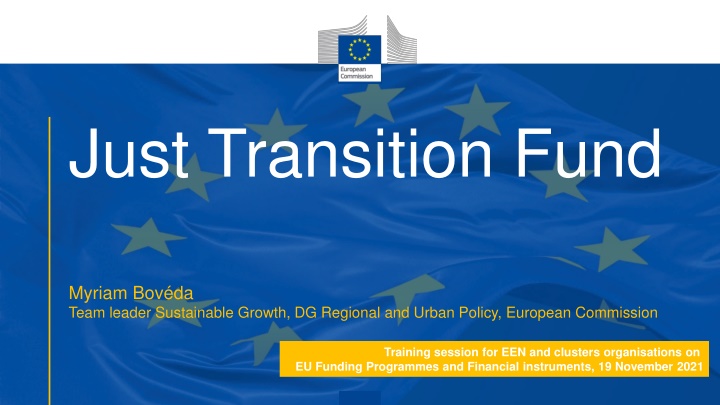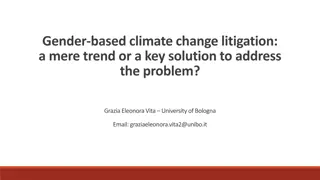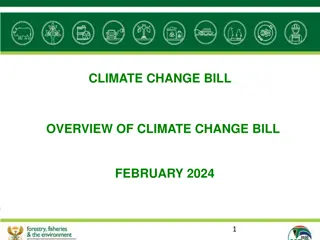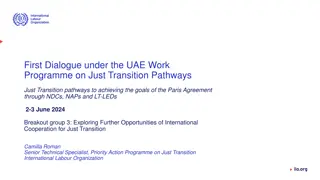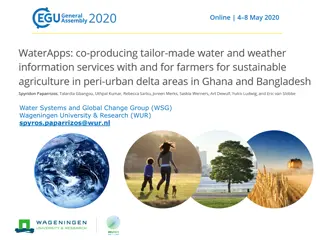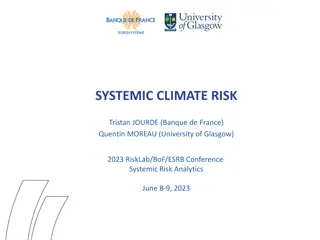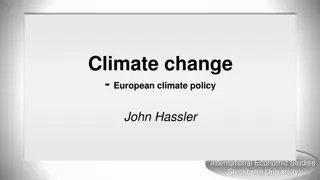EU Just Transition Fund: Supporting Sustainable Growth and Climate Action
The European Commission's Just Transition Fund aims to support regions facing transition challenges by promoting clean energy, sustainable transport, greener industry, nature protection, and a just transition for all. The fund leverages public financing, provides grants, and crowds in private investment to finance green projects and ensure energy-efficient homes. It focuses on regions highly dependent on carbon-intensive industries, offering restructuring support and training for workers. The Fund also allocates billions of Euros to Member States for a smooth transition towards a sustainable economy.
Download Presentation

Please find below an Image/Link to download the presentation.
The content on the website is provided AS IS for your information and personal use only. It may not be sold, licensed, or shared on other websites without obtaining consent from the author.If you encounter any issues during the download, it is possible that the publisher has removed the file from their server.
You are allowed to download the files provided on this website for personal or commercial use, subject to the condition that they are used lawfully. All files are the property of their respective owners.
The content on the website is provided AS IS for your information and personal use only. It may not be sold, licensed, or shared on other websites without obtaining consent from the author.
E N D
Presentation Transcript
Just Transition Fund Myriam Bov da Team leader Sustainable Growth, DG Regional and Urban Policy, European Commission Training session for EEN and clusters organisations on EU Funding Programmes and Financial instruments, 19 November 2021
CLIMATE PACT AND CLIMATE LAW PROMOTING CLEAN ENERGY INVESTING IN SMARTER, MORE SUSTAINABLE TRANSPORT STRIVING FOR GREENER INDUSTRY PROTECTING NATURE THE EUROPEAN GREEN DEAL FROM FARM TO FORK ELIMINATING POLLUTION LEADING THE GREEN CHANGE GLOBALLY ENSURING A JUST TRANSITION FOR ALL FINANCING GREEN PROJECTS MAKING HOMES ENERGY EFFICIENT
Just Transition Mechanism to support and finance regions most exposed to transition challenges in all Member States InvestEU Dedicated Just Transition Scheme Public sector loan facility with the EIB Just Transition Fund (EUR 19.2 billion) Provides primarily grants Crowds in private investment Leverages public financing The JTM includes a governance framework centered on territorial just transition plans
Just Transition Fund Allocations 4000 3500 3000 2500 million EUR 2000 1500 1000 500 0 BE BG CZ DK DE EE IE EL ES FR HR IT CY Member State LV LT LU HU MT NL AT PL PT RO SI SK FI SE NGEU MFF
CARBON-INTENSIVE INDUSTRIES highly-greenhouse gas intensive activities will undergo a deep transformation FOSSIL FUELS Fossil fuel mining and extraction will face a significant decline Regions and territories highly dependent on these activities will need to: restructure their industries, ensure that new economic activities can keep the economic and social texture together, respecting the environment, and provide the necessary training to the workers concerned to find new jobs.
Commission recommendations: priority sectors COAL / LIGNITE PEAT METALS CHEMICALS PETROLEUM REFINERIES CEMENT FERTILISERS SHALE OIL FOSSIL FUEL BASED ENERGY PRODUCTION OTHER
JTF geographical scope Commission recommendations: European Semester Country Reports 2020, Annex D bis Requests for extension should take into account: o sector undergoing transition o definition of the area (incl. evolution of population covered) o coherence with Annex D bis (incl. resulting aid intensities) o negative socio-economic impacts to be addressed (incl. potential job losses linked to climate transition) Formal validation happens by adopting the Programmes Fossil fuels production and fossil fuel based energy generation Carbon-intensive industries Both of the above
JTF programming Member States shall prepare, together with the relevant local and regional authorities of the territories concerned, one or more territorial just transition plans (JTF Regulation) Possibilities of programme architecture: Programming level: national or regional or combination of both Programming options under mono-fund and multi-fund programmes: Option1: JTF axis in an ERDF or CF monofund programme Option 2: JTF axis in an ESF monofund programme Option 3: JTF axis in an ERDF/CF/ESF multifund programme Option4: JTF in a self-standing JTF monofund programme TJTP: part of cohesion policy programmes
Thesocioeconomic logic of the TJTPs A territory faces social, economic and environmental challenges of the transition towards a climate-neutral economy, because it relies heavily on fossil fuels especially coal, lignite, peat, oil shale and/or carbon-intensive industries. A territory sets out a transition process, which foresees: 1. What will happen with the regional economy and with the economic sectors concerned? 2. Will they be phased out? Or will they have to transform? 3. What is the impact on workers and local communities? How will the economic fabric of the territory be redeveloped? What activities beyond diversification? 1. Is there a need to support investments in ETS sectors to achieve significant reduction of emissions and preserve jobs? 2. Is there a need to support investments in large enterprises to offset job loses?
Just Transition Fund: scope of support Stronger focus in scope of intervention than other cohesion programmes Economic diversification and reconversion Re-skilling and job seeking assistance for workers Support to climate and environmental sustainability, where this will help mitigate the impact of the transition Limited additional eligibility to be justified in territorial just transition plans Productive investments in large enterprises: if needed to offset job losses Investments reducing GHG emissions from ETS activities: if needed to preserve jobs Exclusion from the scope of support : Production, processing, distribution, storage or combustion of fossil fuels excluded from support Each operation must contribute to the implementation of the territorial just transition plans Exclusive list of activities defined in Article 4 of the JTF regulation
Next steps: working together to optimise impact Strongpartnership: involvement of all relevant stakeholders in the preparation of cohesion policy programmes Strong programmes: objective setting, types of actions, synergies, funding, outputs and results Awareness raising, coordination and cooperation between national and regional actors
More information https://ec.europa.eu/info/eu-regional-and-urban-development Managing authorities - Regional Policy - European Commission (europa.eu)
Contact myriam.boveda@ec.europa.eu DG REGIO, Smart and Sustainable Growth Unit
Supporting specific operations? Even if an operation is eligible, its possible support depends on the outcome of the programming negotiations between Commission and Member State In addition, the following considerations apply for any operation: Framework of the discussion: European Semester Country Report 2020 (Annex D) It contributes directly to the JTF specific objective It follows the general logic of the TJTP and contributes to its implementation It takes horizontal principles (e.g. do no significant harm ) into account, see Art. 6a CPR It is in line with provisions of selection of operations, see Art. 67 CPR Final decision: approval of Programme with annexed TJTP
Additional considerations for large enterprises In accordance with Art. 4 JTF, the TJTP needs to demonstrate that such investments fulfil the following conditions: Question: gap analysis to be included in TJTP? they are necessary for the implementation of the TJTP; they contribute to the transition to a climate- neutral economy by 2050 and to related environmental targets; they are necessary for job creation in the identified territory; they do not lead to relocation for mitigating job losses resulting from the transition, by creating or protecting a significant number of jobs; and they do not lead to or result from relocation The gap analysis should include the difference between the expected job losses and the potential of job creation through JTF support (e.g. economic diversification investments for SMEs). The latter can be based on historical evidence of job creation by SMEs in the territory, analysis of current employment by SMEs in the region, surveys on employment perspectives, or other methodologies
Additional considerations for ETS activities In accordance with Art. 4 JTF, the TJTP needs to demonstrate that such investments fulfil the following conditions: Question: significant number of jobs in TJTP? they contribute to the transition to a climate-neutral economy; they lead to a substantial reduction in GHG emissions going substantially below the relevant benchmarks established for free allocation under the ETS Directive; and they are required for the protection of a significant number of jobs in a given territory The number of protected jobs should be estimated in a tailored way, with regard to the overall jobs of the concerned economic operators and the labour force in the concerned territories.
